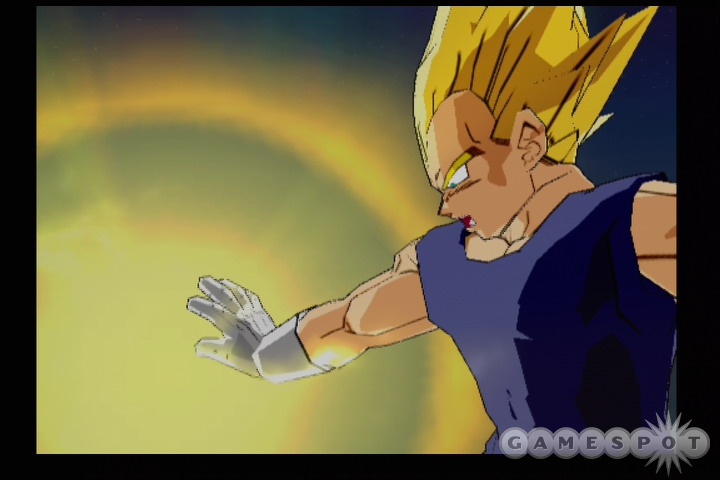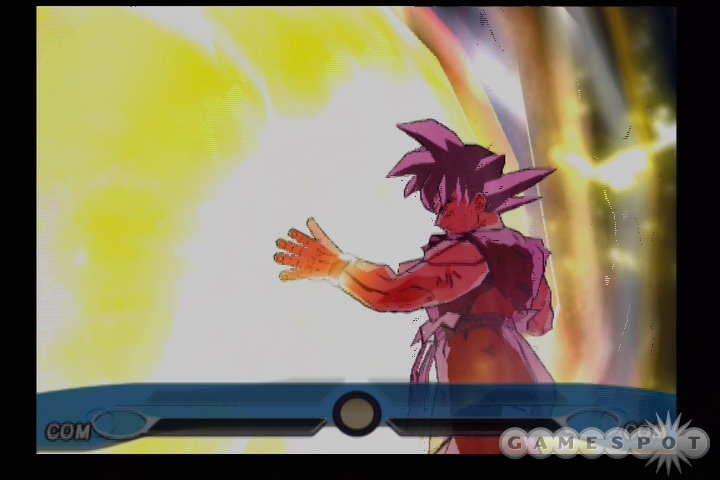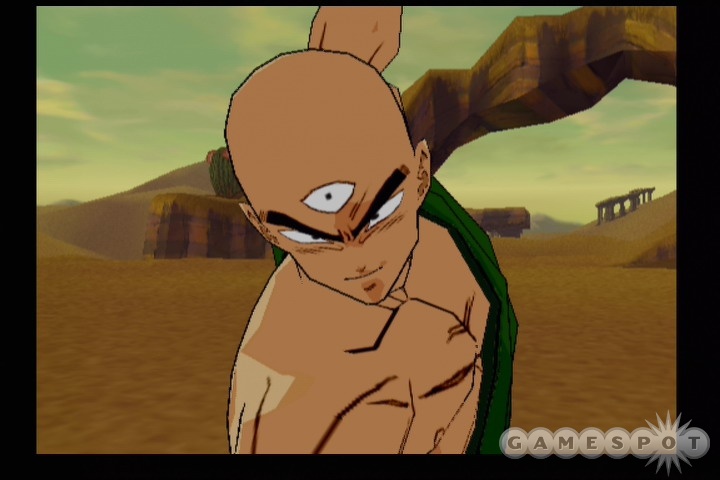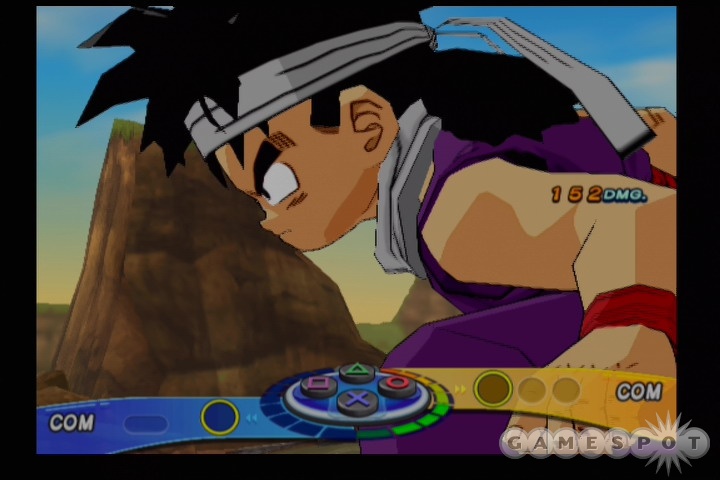With a long, sullied history of extremely poor DBZ games before it, Dragon Ball Z: Budokai was a bit of a revelation when it was released in 2002. Here was a 3D fighting game that, while not offering the deepest combat system, was still reasonably fun to play. Moreover, it featured a great story mode that basically summed up the entire run of the Dragon Ball Z manga-cum-anime in just a few hours. A year later, we got a sequel with improved cel-shaded graphics, but the slick story mode was replaced by a lame board game, and the additions made to the gameplay just didn't seem to mesh with what was already there. Dimps, the little-known developer responsible for the entire Budokai series, learned some lessons and has now returned to the scene with Dragon Ball Z: Budokai 3. This is far and away the best Dragon Ball Z game around, and it's a must-have for DBZ fans. However, the action is also so fast-paced and viscerally satisfying that it can genuinely appeal even to those otherwise uninterested in Dragon Ball Z.

The action in the Budokai games has never been particularly technical, and though Budokai 3 retains all the fundamentals, it adds several new gameplay mechanics that have significant impact on the action. The first is the new teleportation counter system, which, following a simple tap of the D pad and the X button at the right moment, will instantly teleport you right behind your opponent so you can deliver unto him or her a nice, crushing blow. If your opponent is quick enough on his or her feet, though, he or she can pull a reversal and teleport behind you, keeping this move from being an overpowered one. This little teleport maneuver can also be used to pop up behind your opponent after he or she has been knocked through the air, which lets you ping-pong him or her back and forth a few times. While this may sound like kind of an oddball mechanic to outsiders, Dragon Ball Z fans will recognize it as an integral part of just about any DBZ fight.
Also key to Dragon Ball Z are massive energy attacks, which the Budokai series has dutifully represented. Budokai 3 is the first entry in the series to introduce the concept of a "beam struggle," which basically involves two characters throwing a massive beam of energy at each other. Each then tries to overpower the other's beam. Once you find yourself locked in a beam struggle, all you need to do is rotate the analog sticks or mash on the buttons as fast as you can while hoping that you're faster than your opponent. Tactically, it's not a big deal, but it brings the gameplay experience that much closer to the source material. Also, some very heavy lighting and particle effects make the beam struggles look extremely cool.

All of your energy-based moves use up ki, which is represented by a set of bars that are separate from your life-energy bar. You can fill up these bars just by connecting with your attacks, or if there's a lull in the action, you can stand still and power up, which fills your meter rapidly but exposes you to attacks. Keeping your ki meter full is of paramount importance, because your basic punch, kick, and grapple moves won't have as much of an effect when your ki meter is empty. Ki is also needed for transformations, such as when Frieza evolves through his different forms or when any of the Saiyans want to go into their blonde-hair, blue-eyed super-Saiyan mode. But probably the most important use of ki in Budokai 3 involves hyper mode. If you have enough ki (four bars will do), you can press all four face buttons to enter hyper mode. The intense red glow given off by characters in hyper mode is unmistakable, and when they're in this state, they have a few moves they can't execute otherwise.
The dragon rush is the most important move strategically, just because it comes into play more often than other moves. If you're in hyper mode and you have your opponent on the ropes, a well-timed press of the circle button will launch a dragon rush, which boils the rock-paper-scissors underpinning of all fighting games down to its very essence. The camera cuts from the usual side-profile position to give more-cinematic shots of the character that launched the dragon rush to unleash incredible pummeling attacks on his or her opponent. However, the attacker has to get a little lucky if he or she wants to do the most possible damage. At three points during the dragon rush, both players have to press one of the face buttons. If the attacker can avoid hitting the same button as the player being attacked at each of these intervals, the series of attacks will end with a punishing energy blast. If the button presses match up at any point, though, the defender can cancel out the dragon rush and go back to regular action. The action is so incredibly over-the-top, and the camera cuts so perfectly, that the dragon rush is mind-blowing the first time you see it. The downer is that the dragon rush is basically the same for every single character, though there are a few subtle permutations based on specific characters and specific environments. More variety would have been nice, but the dragon rushes are still fantastic additions to the action.
Aside from wearing down on your opponent's life-energy bar, successful dragon rushes will cause your opponent to become fatigued. If your opponent's color-coded fatigue meter goes red, and you're in hyper mode, it's a great time to launch your ultimate-attack finishing move. Just pressing all four face buttons at once will initiate the ultimate attack, but even then your opponent still has a chance, because you'll need superior timing to fill up a special meter at the bottom of the screen with three well-timed button presses. Like the dragon rush, the ultimate attack goes for incredibly over-the-top, dramatic cuts, and the attacks themselves are downright ludicrous. Take Nappa's ultimate move, for example, which, at one point during its execution, can be seen from space. Insane.

There are also some subtler touches that have been added, like the way well-timed taps of the guard button (when trying to avoid up-close melee attacks) will cause your character to quickly dodge blows without moving out of position. This invariably helps add to the hyperkinetic feel of the gameplay. What's really interesting about all the changes that Dimps has made to the gameplay model in Budokai 3 is that though it makes the action slightly more technical, it's not for the sake of making play more like other serious, more straightforward fighters. Rather, the changes make the game feel as much like the show as possible. In this respect, Budokai 3 is quite successful.
The biggest shortcoming in last year's Budokai 2 was its core single-player game, DragonWorld. Budokai 3 loses the crummy board game and comes back with DragonUniverse, which feels more like the story mode in the original Budokai, except that there's a unique story for each of the Z warriors. It's basically just a wrapper for a series of fights with specific opponents, but exploring the overworld map can net you some cool, little extras. The DragonUniverse also introduces a role-playing-game element, because you'll gain experience points in battle that can be used to increase seven different stats that directly impact the performance of your character. In an extremely strange twist, you're given a pass code every time you make a change to a character, which you can punch into an Atari Web site and post, allowing other players to essentially fight against your character.
The DragonUniverse mode is a definite improvement over the DragonWorld board game. However, there are definite chinks in the armor, the biggest of which is its presentation of the action. The original Budokai's story mode provided a Reader's Digest version of the action, with in-engine cutscenes that reenacted memorable moments from the show. It had to leave out a lot, and parts were kind of confusing if you didn't know the story already, although it generally worked. In the DragonUniverse mode, the story sequences are relayed by both still-frame shots of the characters and voice-overs. The game will often infer that there is some action happening by just showing a background and providing some action-packed sound effects. It can often feel like placeholder material, and occasionally it can just be confusing, even for those who know Dragon Ball Z up and down.
Additionally, there's a standard duel mode where you can play against the computer or a second player. Though if you just like the game's pretty colors, you can set up a CPU-versus-CPU match. There's also a ladder-style world tournament competition that will allow up to eight human contestants to participate. With all these different modes and a font of unlockable characters, costumes, and environments, Budokai 3 has great lasting value, whether you're playing by yourself or against your friends.
The gameplay in Budokai 3 already makes it the most fun entry in the series, but the visuals really seal the deal. The cel-shaded character models introduced in Budokai 2 have been cleaned up a bit, and the environments look better. But it's the expert use of special effects, some cool new animations, and great, dramatic cameras that really improve the visuals and elevate the overall experience. The entire game just crackles with power now. Even when standing still, a cool-looking glow will emanate from a character. Energy blasts feel like they have incredible force, with nice, light bleed and splash effects really making the energy seem tangible. The game makes plenty of nods to its 2D anime roots by featuring small impact bursts that appear whenever attacks connect, plumes of dust that characters kick up when they fly across the landscape, small black motion lines that trail fast movements, and quick cuts and cool angles during the dragon rush and ultimate-attack sequences. As mentioned before, it's unfortunate that some of the animations are recycled, and it would've been nice to see the story portions of the DragonUniverse mode actually acted out. However, aside from these considerable points, Budokai 3 still looks stunning.

Furthering the game's authenticity is a sound design that has had every element lifted from the Dragon Ball Z anime. The sound effects are all straight from the show, and whether you like them or not, they're key in conveying the show's energy. Virtually the entire American voice cast puts in work here, as they have in the past two games. There are some random, odd occasions where voice work wasn't recorded, and sometimes characters just "speak" in speech bubbles. This isn't detrimental to the game, though. Interestingly, there are a few characters that are presented, voice-wise, in a manner that makes you get the sense that perhaps the actors have started to grow weary of their voice roles. In general, the voice acting is pretty solid. There are plenty of familiar musical themes, as well as some jamming new pieces that combine high-energy synthesizers and rock guitars for a sound that's maybe a little bit corny but always appropriate for the subject matter.
If you're a Dragon Ball Z fan, you want this game. It re-creates the DBZ experience better than any other offering before it. And while there's definitely a lot of fan service here, the gameplay is also just plain fun, so anyone who's up for a simple, high-impact fighting game should have a blast with Dragon Ball Z: Budokai 3.